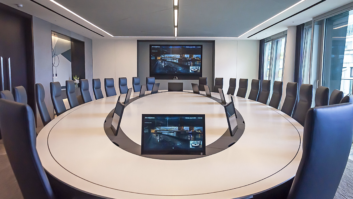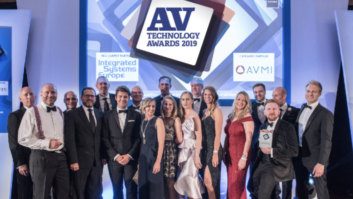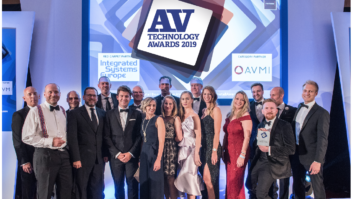Our final preview of the AV Technology Awards Project awards brings us to the nominees in the Venue Project of the Year and Visitor Attraction project of the Year categories.
This year’s awards will be announced during a brand new digital Awards Week running from 23rd to 25th June. The awards programme is held in association with Awards Partners Crestron, Integrated Systems Europe, and the Technological Innovations Group (TIG), and Association Partners AV User Group and Women in AV (WAVE).
Nominees for Venue Project of the Year
Diversified: Melbourne Cricket Ground
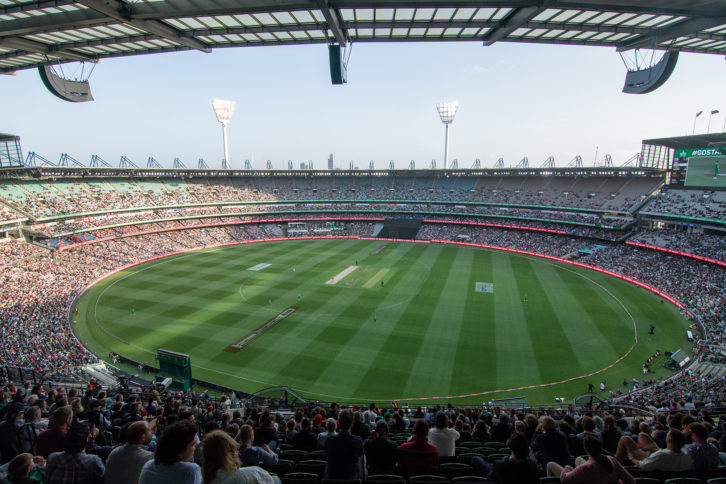
Diversified was the head contractor for the public address (PA) and emergency warning intercommunication system (EWIS) upgrade at the Melbourne Cricket Ground (MCG). Working closely with Grounds manager, Melbourne Cricket Club (MCC), and audio consultant Auditoria, this project delivered an audio infrastructure providing fans “an exceptional game day experience, connecting them to the drama and excitement on-field”.
Part of the MCC’s ‘Smart Stadium Strategy’, this AUD$25 million project was a complete refurbishment of audio technology throughout the stadium, including bowl PA, concourses, bars and function areas, gate entry and exit points, and broadcast facilities, connecting it to a converged network for easier audio management.
Genelec: G Livelab
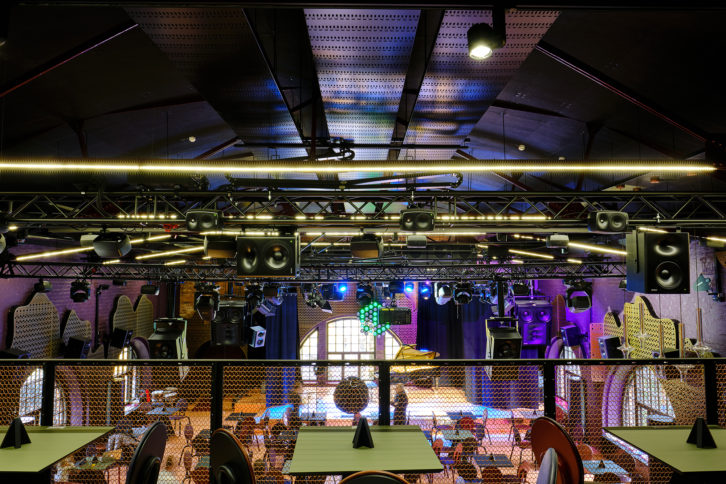
In the wake of the success of G Livelab Helsinki, the Finnish Musicians’ Union has opened a brand new – and bigger – venue in the city of Tampere, 200km north of the Finnish capital. The same team was deployed to realise the Tampere project, which is built according to the same ‘music first’ philosophy as Helsinki. The result is “an extraordinary live music experience based on quality programming, modern design, and state-of-the-art Genelec audio systems including the new 4430 Smart IP loudspeaker”.
The venue hosts up to 250 people and offers a hugely varied programme including jazz, folk, world music, pop/rock, chamber music, electronic music and more. Akukon Oy designed the acoustics, electroacoustics, lighting, sound, video, communication systems and basic IT structure as well as the rigging systems, as they did for Helsinki, working with Nordic AV integrator, Bright.
NanoLumens: Legacy Union Lobby
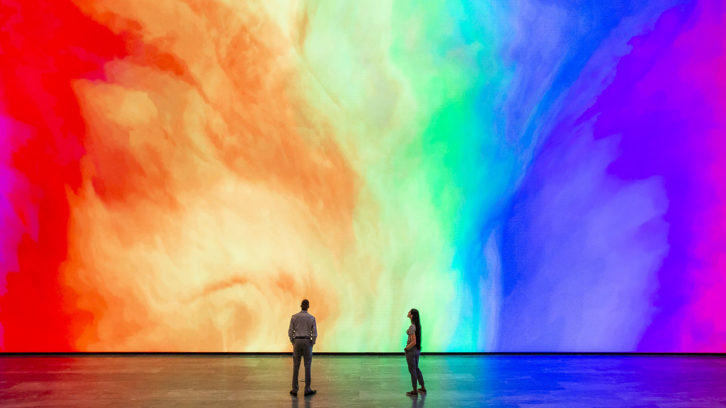
One of the main challenges faced by Legacy Union in its pursuit of transforming the lobby of Bank of America Tower in Uptown Charlotte with a dynamic art experience was the sheer size of the task.
The tall two-story glass windows that enclose the lobby allow plenty of ambient light into the space which posed challenges for display options. With integration help from Cenero, architectural expertise from LS3P, and content from Second Story, NanoLumens installed a 64-foot wide by 36-foot tall LED display with a total surface area nearly 3.5 times the size of a highway billboard. The display will show a variety of sports content, marketing messaging, and local scenes, with design studio Second Story creating full-screen imagery. This 4.7mm pixel pitch NanoLumens display is believed by the company to be the largest native 4K display ever installed indoors.
Riedel Communications: Eurovision Song Contest 2019
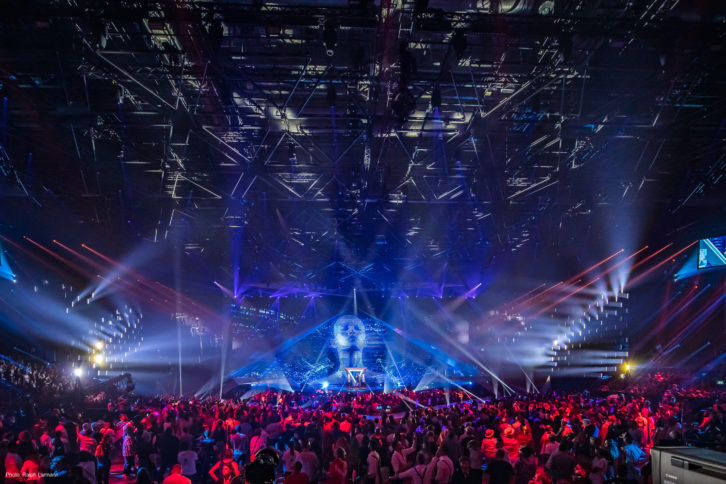
The 2019 European Song Contest (ESC), the world’s longest-running international television song competition, chose Riedel Communications for the 14th consecutive year to provide a comprehensive and advanced intercom and signal distribution solution. Riedel supplied a 360-degree managed technology service together with the signal transport and communications equipment to enable the world broadcast feed. Riedel Managed Technology also supported the production with a 30-member onsite engineering team.
The 2019 ESC broadcast from the Tel Aviv Expo faced tremendous comms and signal distribution challenges. Specific requirements included not only intercom and signal distribution, but also accreditation, access control, commentary systems, and a comprehensive IT infrastructure for staff, broadcasters, and attending press members.
“Take it from me: pulling off the European Song Contest is a massive undertaking that gets bigger and bigger every year. But year after year, Riedel is up to the task,” said ESC’s Ola Melzig.
Meyer Sound and Solotech: The Colosseum at Caesars Palace
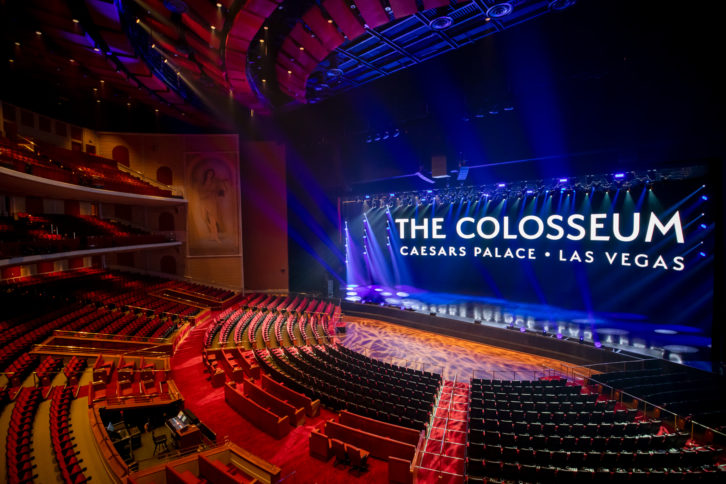
The Colosseum at Caesars Palace relaunched in September 2019. The renovated venue has “maximised flexibility across world-class sound, lighting and video systems that maintains integrity and high production values”. Meyer Sound was selected for the venue’s “sonic solution”, with its LEO Family system and LYON arrays supplied and installed by Solotech.
Overall scenic and AV design was entrusted to Montreal theater designers Sceno Plus. Keith Wright of Production Specialists of Las Vegas (PSLV), who represented Caesars Entertainment as a consultant on the project, supervised the specifics of AV design and integration. He said, “Meyer and Solotech had proved themselves with 16 fantastic years in that venue… They knew this room better than anybody else, and through all that time their support was unmatched.”
Technical Direction Company: The Schools Spectacular
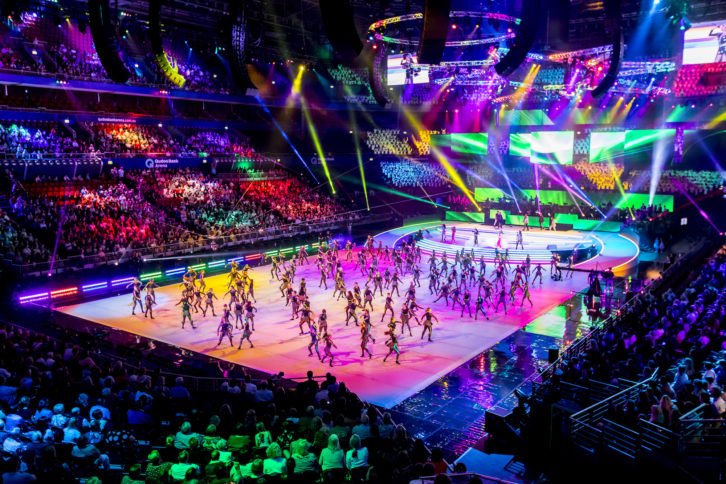
Every year for the past 36 years, Australia’s NSW Department of Education has presented The Schools Spectacular, which holds the Guinness World Record for ‘Largest Amateur Variety Act’ with over 5,500 performers including singers, dancers, drama performers, poets, aerialists and circus acts.
TDC (the Technical Direction Company) has provided the video technology and broadcast record support for the last nine years. For the 2019 event, TDC rigged 19 LED screens in a variety of positions and used an array of carefully positioned Barco UDX projectors to ensure the entire arena floor, main stage and ramps were seamlessly blended and mapped or projected content.
Nominees for Visitor Attraction Project of the Year
BrightSign: Burj Khalifa, cracking glass floor
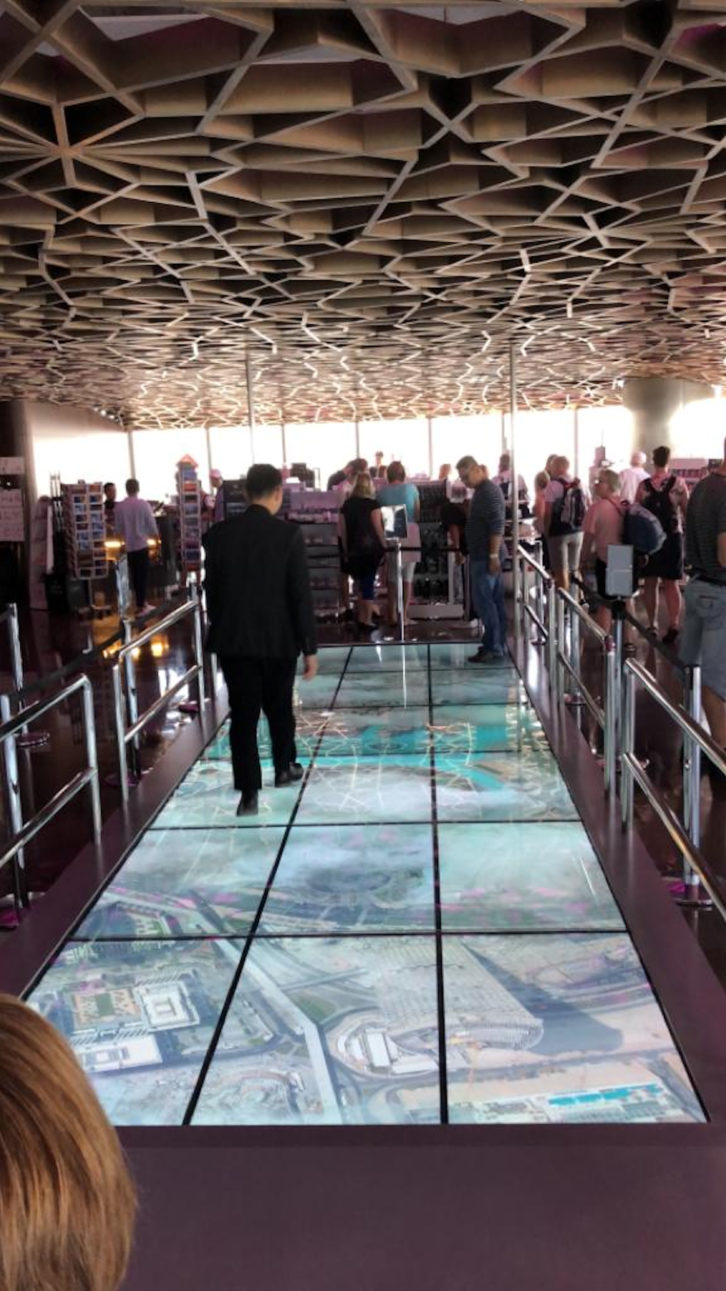
Digicomm deployed BrightSign players, motion sensors, floor mounted OLED screens and unique content to create a “spectacular cracking glass floor” at the top of Burj Khalifa, the world’s tallest building.
The tower’s owners Emaar Properties looked to create a new attraction on the 125th floor of the building known as ‘At the Top’, which receives around 10,000 visitors a day. Together with digital media partner LG, they developed the concept of an interactive, realistic simulation of a glass floor above the city that appears to crack when stepped on.
Digicomm installed eighteen LG 55-inch OLED 8K resolution toughened glass screens in the floor, powered by two BrightSign XT1144 expanded I/O players. The screens display a highly realistic visual animation of the city 456m below, which changes according to the time of day and season, scheduled and controlled by the BrightSign players. When a visitor trips a sensor, a virtual crack starts forming on the skywalk floor and escalates; as they keep walking, the glass is cracking beneath them.
Diversified: Statue of Liberty Museum
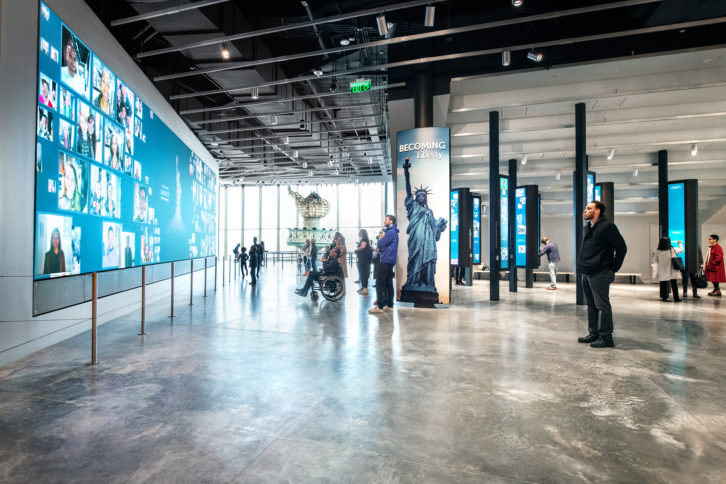
The Statue of Liberty-Ellis Island Foundation commissioned a “highly accessible museum experience that would immerse visitors in the emotional story of the Statue of Liberty”. ESI Design designed the new museum’s content and visitor experience, collaborating with Diversified’s team of experts from the systems-design phase of the project.
Among the galleries are an Immersive Theater, Star Mural Donor Wall, Engagement Gallery and Becoming Liberty, all built on a flexible technology platform that is simple to operate while providing extensive redundancies for minimal downtime.
“For the Statue of Liberty Museum, it was essential that both the design and execution were faultless. With [Diversified’s] first-class knowledge within the audio visual and technology landscape, we were able to present a cutting-edge museum to its global audience,” said Lawrence Estevez-Smith, director of IT for the Statue of Liberty-Ellis Island Foundation.
Eclipse Digital Media: Wembley Park Bobby Moore Bridge digital transformation
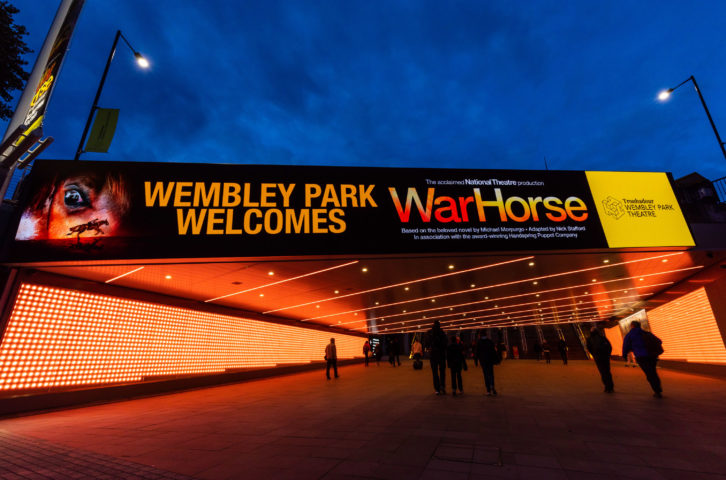
As part of its development project, Wembley Park and Quintain commissioned a Digital Signage upgrade to the Bobby Moore Bridge. The bridge underpass is the pedestrian route into Wembley Park from Wembley Park Underground Station providing access to visitor attractions such as the iconic Wembley Stadium, The SSE Arena, London Designer Outlet and Troubadour Theatre.
Eclipse Digital Media was commissioned to undertake the project, and enhanced the area with a new custom LED screens and lighting system. The system includes over 100m2 Absen XD6 LED panels in two high-resolution outdoor LED screens, fitted to the northern and southern parapets of the bridge. Under the bridge, there are a series of LED lights behind diffuse glass panels to create a ‘dot’ effect, in keeping with the original tile artwork at the site, and finally, low resolution LED strips have been spread out across the ceiling in linear rows.
Electrosonic: Europa Park
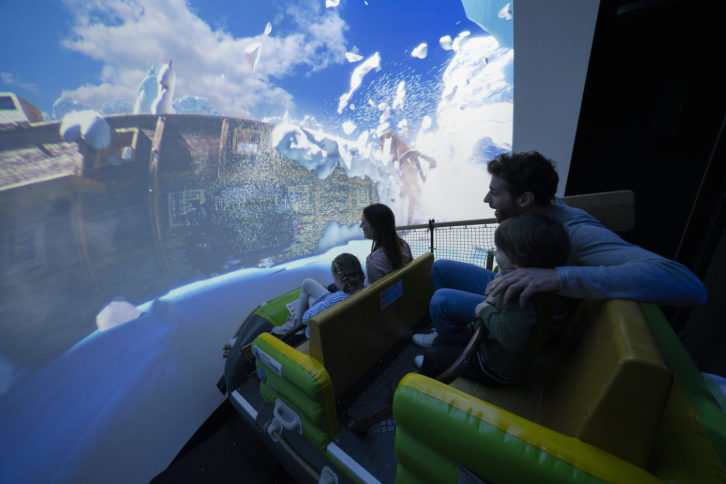
The Snorri Touren dark ride integrates large-scale, big-budget audiovisual technology into a very small space to create the “most immersive attraction of this scale in the world”. The ride was designed to combine traditional dark ride techniques such as animatronics and elaborate sets with advanced technologies such as dome projection, integrated media, waterfall projection and projection mapping. Quality was also a major requirement with movie-image quality, powerful multi-track audio and fully uncompressed 4K content on 17 screens.
Electrosonic was responsible for the engineering, deployment and integration of the ride, working in partnership with Mack Solutions, Mack Animations, Jora Vision, T-Gix and Emis to deliver Europa Park’s concept and design. Electrosonic’s services covered technology design consulting, build and systems integration, speciality projection, audio and acoustics, immersive technologies and show control systems.
Kraftwerk Living Technologies: experimenta Science Dome
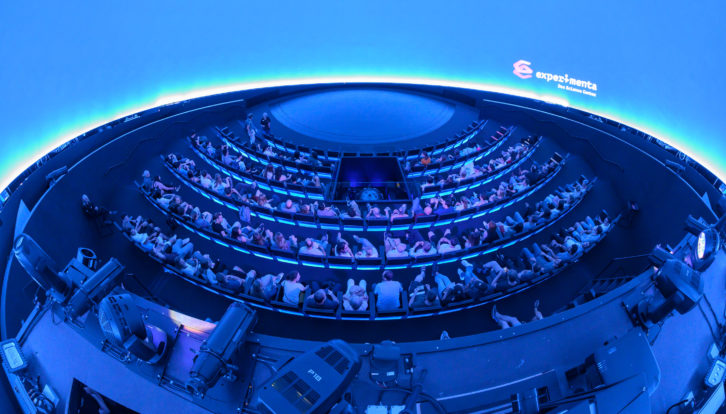
The Science Dome of the new experimenta in Heilbronn, the largest Science Center in Germany, is a “multipurpose venue featuring the latest in stage and AV technology”. The venue boasts a rotating auditorium including a multi-projector system as well as an opto-mechanical star projector under a 700 m² dome. The hybrid dome is enhanced with several special effects such as lasers and water.
Kraftwerk Living Technologies (KLT) was responsible for the development of the now patented dome concept as well as general contractor for the project. The audience is seated on an individually developed rotating platform that can be turned 180-degrees and is covered by a 726 m² dome, with a diameter of 21.5 m and made of free-hanging aluminum construction. There are 150 seats and two modes: event and dome. In event mode the audience faces a 170 m² stage area equipped with the latest in stage technology to watch lectures, digital cinema performances or theater and music productions. Dome mode uses the full projection area of the dome screen for 3D fulldome and planetarium shows.
RealMotion: Seminole Hard Rock Hotel & Casino in Hollywood, Florida
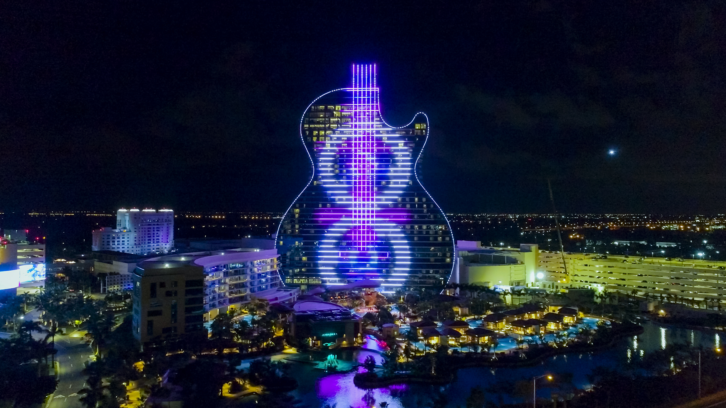
RealMotion recently brought its expertise to the launch of the world’s first guitar-shaped hotel, the Seminole Hard Rock Hotel & Casino in Hollywood, Florida.
Powered by a single RealMotion 4 Karat Gold Series server, the entire facade of the 400-foot-tall, $1.5 billion hotel is now one of the world’s most unique digital sculptures, capable of presenting a multitude of dazzling visual effects and presentations that utilise 2.3 million LED lights, video mapping and lasers. The project was managed, directed, engineered and installed by Boston-based custom fabricator DCL (Design Communications LTD). The project commenced in October 2017 and concluded two years later in October 2019.
Holovis: Royal Liver Building 360
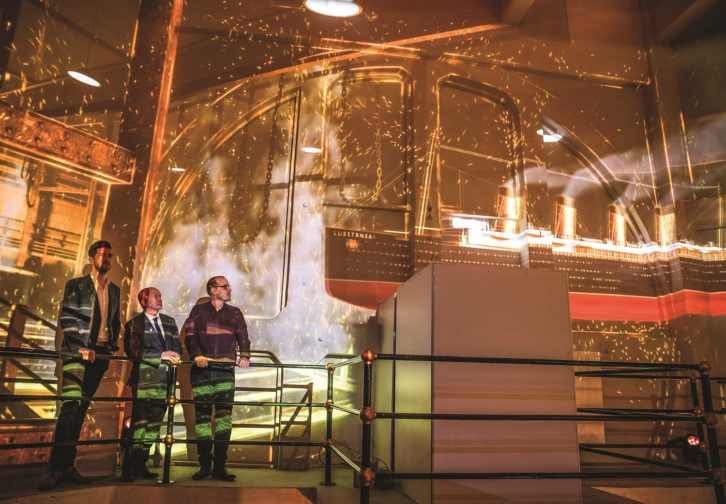
The Royal Liver Building in Liverpool, one of the most iconic pieces of British architecture outside of the capital, has been transformed into “a canvas for a multisensory projection mapped extravaganza” to immerse guests into the city’s vibrant history.
Holovis was tasked by operator Heritage Great Britain to create a nine minute experience that transforms the Clock Tower into a time warp, immersing visitors into the history of Liverpool. The space has a viewing platform that holds just 14 guests per session, making it an intimate environment to tell the story.
Holovis decided that the best way to tell this story to an audience was through projection mapping with surround audio to complete the multisensory immersion. However, unlike traditional projection mapped shows that take place on a flat canvas, Holovis decided to use the whole space visible to the audience, surrounding them with 270-degree visuals to really immerse them into the story.
URTV/Brian Keating: Scottish Submarine Centre
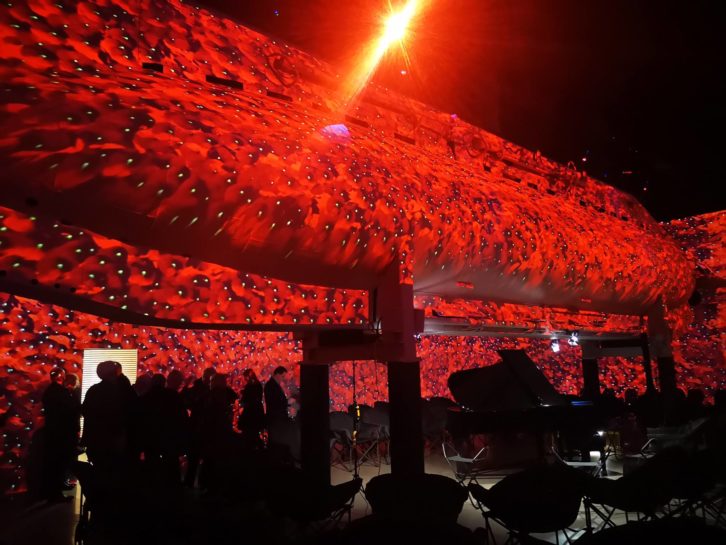
Brian Keating explains the project: “We had to find a new way to present x51, the last miniature submarine built by the Royal Navy. We wanted to allow visitors to explore inside the submarine, (impossible to access due to danger of a confined space), to show how it worked and to show how the crew of 5 men operated it under water.
“We designed, created and developed an immersive space to house the artefact. We used a group of eight elevated NEC laser projectors to map onto the outside of the submarine, 18 NEC lasers blended together to project onto a built wall (with 32 secreted speakers) which surrounds the submarine and enclose the exhibition space. In total £1.2m was spent creating the home for x51 at the Scottish Submarine Centre.
“Once installed, mapped and calibrated, we began an intense and painstaking 3D capture and modelling exercise of the 1,900 key elements inside the submarine, photo realistic capture and texturing of each item, cataloging and then recomposing of the digital items together. This enables us to show the inside of the submarine, at scale, with moveable parts on the outside of the submarine. We called this Inside Out.”

